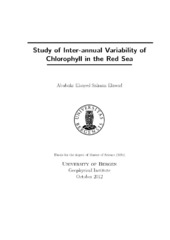Study of Inter-annual Variability of Chlorophyll in the Red Sea
Master thesis
Permanent lenke
https://hdl.handle.net/1956/7104Utgivelsesdato
2012-10-01Metadata
Vis full innførselSamlinger
- Geophysical Institute [1198]
Sammendrag
This thesis studies and estimates interannual chlorophyll-a concentration in the Red Sea water using SeaWIFS, MERIS and MOIDS data. We use the data of Chlorophyll-a (CHL-a) for the period from 1998 to 2009 as well as other physical parameters such as, sea surface temperature (SST), photosynthetic available radiation (PAR), wind and mixed layer depth (MLD) to study what control the interannual variations of phytoplankton blooms in the Red Sea. The area under study is divided into three zones which cover the north, the middle and the south zones of the Red Sea. When considering the data seasonally, the CHL-a shows that blooms always occur in the Red Sea during winter. For each zone, the start and the end of the blooms are different from other zones. During all three zones, the CHL-a is increasing during winter and decreasing during the summer for example, the average high value of CHL-a in the north zone during the blooms is (0.26 mg/m3) and the minimum value is (0.14 mg/m3). only in the south the blooms started in the summer in September and the highest value of CHL-a during the blooms recored is the south too (0.9 mg/m3). The study shows that the physical parameters have effect in the blooms sizes In each zone, significant correlations between CHL-a and some of the physical parameters is found indicating how physical processes may control the phytoplankton blooms in the study area. such as the wind in the south showed up the controloing of CHL-a by the positive correlation that CHL-a and wind had during the blooms (0.740). Interannual variations are computed as monthly anomalies relative to the 1998- 2009 monthly climatology. In this way, the effect of co-variation between different variables on the seasonal time scale is minimized, The anomaly data showed clear vii Abstract interannual variations in almost all parameter and zones. Strong co-variations between CHL-a and the physical parameters showed that physical process have effect on the interannual changes in the phytoplankton blooms in the Red Sea. Few highly anomalous years in some of the parameters produce a weak long-term (1998-2009) trends. Such as, in the southern zone of the Red Sea when the value of R2=0.0157 according the high value of CHL-a in 2008 and 2009 approximately 0.28 mg/m3 for both of them. The value of R2 becomes 0.0009 when these two years have been removed. October 2012 - Bergen, Norway
